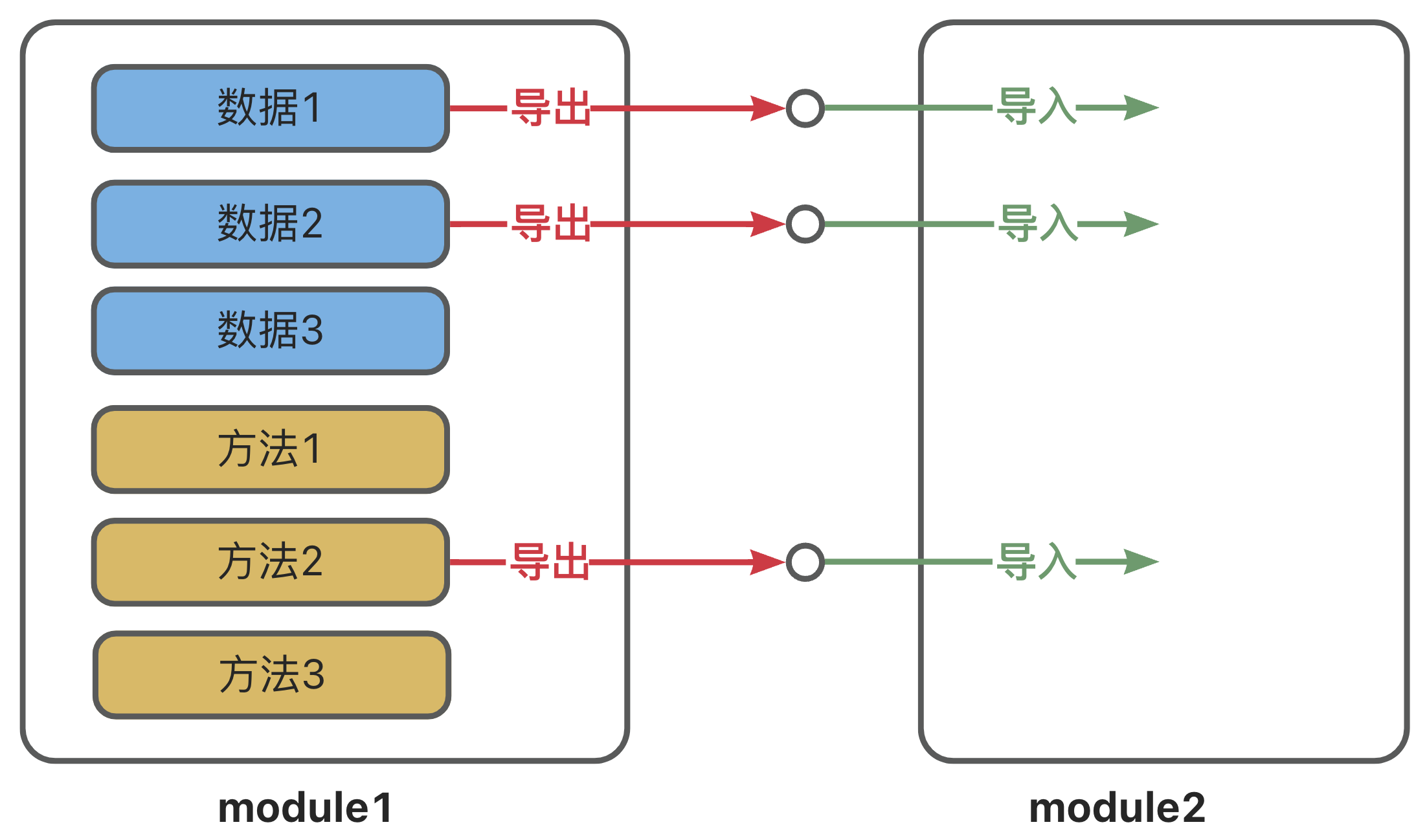模块化
模块化概述
什么是模块化?
- 将程序文件依据一定规则拆分成多个文件,这种编码方式就是模块化的编码方式
- 拆分出来每个文件就是一个模块,模块中的数据都是私有的,模块之间互相隔离
- 同时也能通过一些手段,可以把模块内的指定数据“交出去”,供其他模块使用
为什么需要模块化?
随着应用的复杂度越来越高,其代码量和文件数量都会急剧增加,会逐渐引发以下问题:
- 全局污染问题
- 依赖混乱问题
- 数据安全问题
模块化规范分类
- CommonJS —— 服务端应用广泛
- AMD —— 了解即可
- CMD —— 了解即可
- ES6 模块化 —— 浏览器端应用广泛
导入与导出的概念
模块化的核心思想就是:模块之间是隔离的,通过导入和导出进行数据和功能的共享。
- 导出 (暴露):模块公开其内部的一部分 (如变量、函数等),使这些内容可以被其他模块使用
- 导入 (引入):模块引入和使用其他模块导出的内容,以重用代码和功能

CommonJS 规范
最早仅供服务端使用,后来在浏览器端可以通过 browserify 编译使用。目前在服务端项目中大量使用。
示例
js
const name = "尚硅谷";
const slogan = "让天下没有难学的技术!";
function getTel() {
return "010-56253825";
}
function getCities() {
return ["北京", "上海", "深圳", "成都", "武汉", "西安"];
}
// 通过给 exports 对象添加属性的方式,来导出数据 (注意:此处没有导出 getCities)
exports.name = name;
exports.slogan = slogan;
exports.getTel = getTel;js
const name = "张三";
const motto = "相信明天会更好!";
function getTel() {
return "13877889900";
}
function getHobby() {
return ["抽烟", "喝酒", "烫头"];
}
// 通过给 exports 对象添加属性的方式,来导出数据 (注意:此处没有导出 getHobby)
exports.name = name;
exports.slogan = slogan;
exports.getTel = getTel;js
// 引入school模块暴露的所有内容
const school = require("./school");
// 引入student模块暴露的所有内容
const student = require("./student");导出数据
在 CommonJS 标准中,导出数据有两种方式:
- 第一种方式:
module.exports = { value } - 第二种方式:
exports.name = value
注意
- 每个模块内部的
this、exports、modules.exports在初始时,都指向同一个空对象,该空对象就是当前模块导出的数据 - 无论如何修改导出对象,最终导出的都是
module.exports的值 exports是对module.exports的初始引用,仅为了方便给导出象添加属性,所以不能使用exports = value的形式导出数据,但是可以使用module.exports = xxxx导出数据
导入数据
在 CommonJS 标准中,使用内置的 require 函数进行导入数据
js
// 直接引入模块
const school = require("./school");
// 引入同时解构出要用的数据
const { name, slogan, getTel } = require("./school");
// 引入同时解构+重命名
const { name: stuName, motto, getTel: stuTel } = require("./student");扩展
一个 CommonJS 模块在执行时,是被包裹在一个内置函数中执行的,所以每个模块都有自己的作用域,我们可以通过如下方式验证这一说法:
js
console.log(arguments);
console.log(arguments.callee.toString());内置函数的大致形式如下:
js
function (exports, require, module, __filename, __dirname){
/** */
}浏览器端运行
Node.js 默认是支持 CommonJS 规范的,但浏览器端不支持,所以需要经过编译,步骤如下:
- 全局安装
browserify
sh
npm i browserify -g- 编译
sh
# index.js 是用 CommonJS 写的源文件,build.js 是编译后输出的目标文件
browserify index.js -o build.js- 页面中引入使用
html
<script type="text/javascript" src="./build.js"></script>ES6 模块化规范
ES6 模块化规范是一个官方标准的规范,它是在语言标准的层面上实现了模块化功能,是目前最流行的模块化规范,且浏览器与服务端均支持该规范。 (在服务端运行需要稍微配置一下)
示例
js
// 导出 name
export const name = { str: "尚硅谷" };
// 导出 slogan
export const slogan = "让天下没有难学的技术!";
// 导出 name
export function getTel() {
return "010-56253825";
}
function getCities() {
return ["北京", "上海", "深圳", "成都", "武汉", "西安"];
}js
// 导出 name
export const name = "张三";
// 导出 motto
export const motto = "相信明天会更好!";
// 导出 getTel
export function getTel() {
return "13877889900";
}
function getHobby() {
return ["抽烟", "喝酒", "烫头"];
}js
// 引入 school 模块暴露的所有内容
import * as school from "./school.js";
// 引入 student 模块暴露的所有内容
import * as student from "./student.js";html
<!-- type 要改成 module -->
<script type="module" src="./index.js"></script>Node 中运行 ES6 模块
Node.js 中运行 ES6 模块代码有两种方式:
- 将 JavaScript 文件后缀从
.js改为.mjs,Node 则会自动识别 ES6 模块 - 在
package.json中设置type属性值为module
导出数据
ES6 模块化提供 3 种导出方式:分别导出、统一导出、默认导出
js
// 导出 name
export const name = { str: "尚硅谷" };
// 导出 slogan
export const slogan = "让天下没有难学的技术!";
// 导出 getTel
export function getTel() {
return "010-56253825";
}js
const name = { str: "尚硅谷" };
const slogan = "让天下没有难学的技术!";
function getTel() {
return "010-56253825";
}
function getCities() {
return ["北京", "上海", "深圳", "成都", "武汉", "西安"];
}
// 统一导出 name, slogan, getTel
export { name, slogan, getTel };js
const name = "张三";
const motto = "走自己的路,让别人五路可走!";
function getTel() {
return "13877889900";
}
function getHobby() {
return ["抽烟", "喝酒", "烫头"];
}
// 默认导出:name, motto, getTel
export default { name, motto, getTel };导入数据
对于 ES6 模块化来说,使用何种导入方式,要根据导出方式决定。
1️⃣ 导入全部
可以将模块中的所有导出内容整合到一个对象中。
js
import * as school from "./school.js";2️⃣ 具名导入 (对应导出方式:分别导出、统一导出)
导出数据
js
// 分别导出
export const name = { str: "尚硅谷" };
// 分别导出
export const slogan = "让天下没有难学的技术!";
function getTel() {
return "010-56253825";
}
function getCities() {
return ["北京", "上海", "深圳", "成都", "武汉", "西安"];
}
// 统一导出
export { getTel };具名导入
js
import { name, slogan, getTel } from "./school.js";
// 还可以通过 as 重命名:
import { name as myName, slogan, getTel } from "./school.js";3️⃣ 默认导入 (对应导出方式:默认导出)
导出数据
js
const name = "张三";
const motto = "走自己的路,让别人无路可走!";
function getTel() {
return "13877889900";
}
function getHobby() {
return ["抽烟", "喝酒", "烫头"];
}
//使用默认导出的方式,导出一个对象,对象中包含着数据
export default { name, motto, getTel };默认导入
js
import student from "./student.js"; // 默认导出的名字可以修改,不是必须为 student
console.log(student.name);4️⃣ 动态导入
允许在运行时按需加载模块,返回值是一个 Promise。
js
const school = await import("./school.js");
console.log(school);5️⃣ 不接收数据
例如只是让 mock.js 参与运行
js
import "./mock.js";数据引用问题
1️⃣ CommonJS
分析下方案例
js
// data.js
let sum = 1;
function increment() {
sum++;
}
module.exports = { sum, increment };js
// index.js
const { sum, increment } = require("./data.js");
console.log(sum); // 1
increment();
increment();
console.log(sum); // 1提示
在 index.js 中通过 require 和解构赋值得到的 sum 只是 data.js 中 sum 的一个拷贝,调用 increment 修改的是 data.js 中 sum,不会修改 index.js 中的 sum
2️⃣ ES6
js
// data.js
let sum = 1;
function increment() {
sum++;
}
export { sum, increment };js
// index.js
import { sum, increment } from "./data.js";
console.log(sum); // 1
increment();
increment();
console.log(sum); // 3提示
在 ES6 中就存在这种数据引用的问题 (符号绑定),导出的数据和导入的数据是共用的一块内存空间
export导出的数据 A 和import导入的数据 A 指向的是同一块内存空间,也叫做符号绑定import导入的数据都是当作常量来处理的- 所以在 ES6 中要求导出的数据必须是常量